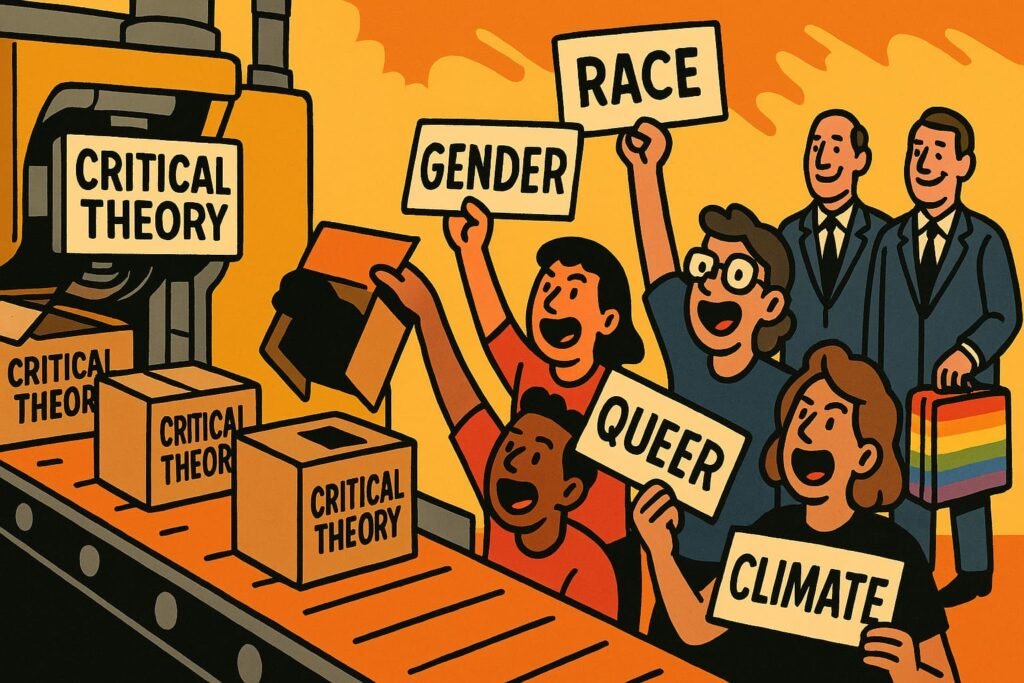Critical Theory in Practice – How Race, Gender, and Queer Theory Took Over
From Theory to Daily Politics
Critical Theory didn’t stay in dusty libraries. It escaped, mutated, and became the operating system of today’s culture wars. What began as a critique of capitalism now dictates how we talk about race, gender, sexuality, disability, and even climate.
The result? Entire “sub-theories” that shape our politics, HR manuals, and outrage cycles on social media. From lecture halls to boardrooms, critique is no longer just a tool — it’s the rulebook.
Race Theory: The World Through “Systemic Racism”
Race Theory, or Critical Race Theory (CRT), reframed racism from a personal failing to a permanent feature of society.
- Core Premise: Racism isn’t about bad apples — it’s baked into the system.
- Key Buzzwords: “White privilege,” “systemic racism,” “anti-racism.”
- Impact: If inequalities exist, they’re treated as proof of racism, regardless of alternative explanations like economics or education.
- Take: A theory that was meant to reveal hidden bias often morphs into a career industry of consultants, trainings, and diversity audits.
Gender Theory: Biology Out, Social Scripts In
Gender Theory argues that gender isn’t rooted in biology but in social performance.
- Core Premise: “Male” and “female” are not natural facts but cultural scripts.
- Key Buzzwords: “Patriarchy,” “gender roles,” “performative masculinity.”
- Impact: Family roles and traditions get reframed as oppressive. Even the idea of biological sex becomes suspicious.
- Take: When everything is performance, the only audience that matters is politics.
Queer Theory: Smashing the Binaries
Queer Theory took the critique further — attacking the very categories of sexuality and identity.
- Core Premise: Stability is oppressive; categories themselves enforce hierarchy.
- Key Buzzwords: “Heteronormativity,” “fluidity,” “non-binary.”
- Impact: Once a niche academic exercise, it now fuels debates over gender pronouns, identity laws, and school curricula.
- Take: It’s the only field where creating new labels is treated as radical activism.
Other Offshoots of Critical Theory
The “critique everything” mindset didn’t stop with race, gender, and sexuality. It spawned entire subfields, each applying the same formula: expose oppression, critique tradition, and demand systemic transformation.
- Disability Studies: Argues that disability is socially constructed — society disables people, not conditions.
- Fat Studies: Frames obesity as an oppression narrative rather than a health issue.
- Postcolonial Theory: Recasts Western history as pure exploitation and theft.
- Climate Justice: Even the environment becomes a story of injustice, inequality, and “colonial carbon footprints.”
- Trans Studies: Expands Gender and Queer Theory, focusing on how traditional categories of male/female are oppressive and how institutions must adapt to affirm identity as self-declared truth.
- Critical Immigration Theory: Reframes borders, citizenship, and migration not as political decisions but as systems of exclusion designed to privilege some groups and oppress others.
Each new branch takes the same critical scalpel to a different area of life, ensuring that critique remains an endless, renewable resource.
Why Critical Theory in Practice Matters Today
These theories now run far beyond academia.
- Universities: Train students to see oppression as the hidden code of society.
- NGOs and Activism: Use the language of justice to rally support.
- Corporations: Adopt “equity pledges” and rainbow logos because critique is cheaper than reforming wages or taxes.
- Politics: Laws and policies increasingly bend to the pressure of identity-based activism.
The irony? A philosophy meant to liberate people from power structures has created a new one — a sprawling network of activists, consultants, HR officers, and politicians who live off perpetual critique.
From Critique to Dogma
Critical Theory in practice no longer asks questions — it issues instructions. Race, Gender, Queer, and their countless offshoots dominate institutions, setting the rules for what can be said, taught, or even thought.
A worldview built on permanent suspicion now drives politics, activism, and business. The question isn’t whether Critical Theory is right or wrong. It’s whether a society built only on critique can ever build anything lasting.
FAQ: Critical Theory in Practice
What does “Critical Theory in Practice” mean?
It refers to the application of Critical Theory to specific areas like race, gender, sexuality, and beyond, turning critique into activism.
How did Critical Race Theory change politics?
It reframed racism as systemic, influencing law, education, and corporate policies, and making “anti-racism” an industry.
What is the main idea of Gender Theory?
That gender is socially constructed, not biologically fixed, leading to debates over roles, identity, and even language.
Why is Queer Theory controversial?
Because it questions categories themselves, promoting fluidity and challenging long-standing norms about sex and identity.
What about Trans Studies and Critical Immigration Theory?
Trans Studies pushes institutions to affirm gender identity as self-declared truth, while Critical Immigration Theory reframes borders and citizenship as oppressive systems.
Why do corporations embrace these theories?
Because adopting the language of critique and equality costs less than addressing deeper economic issues like pay, tax, or working conditions.



